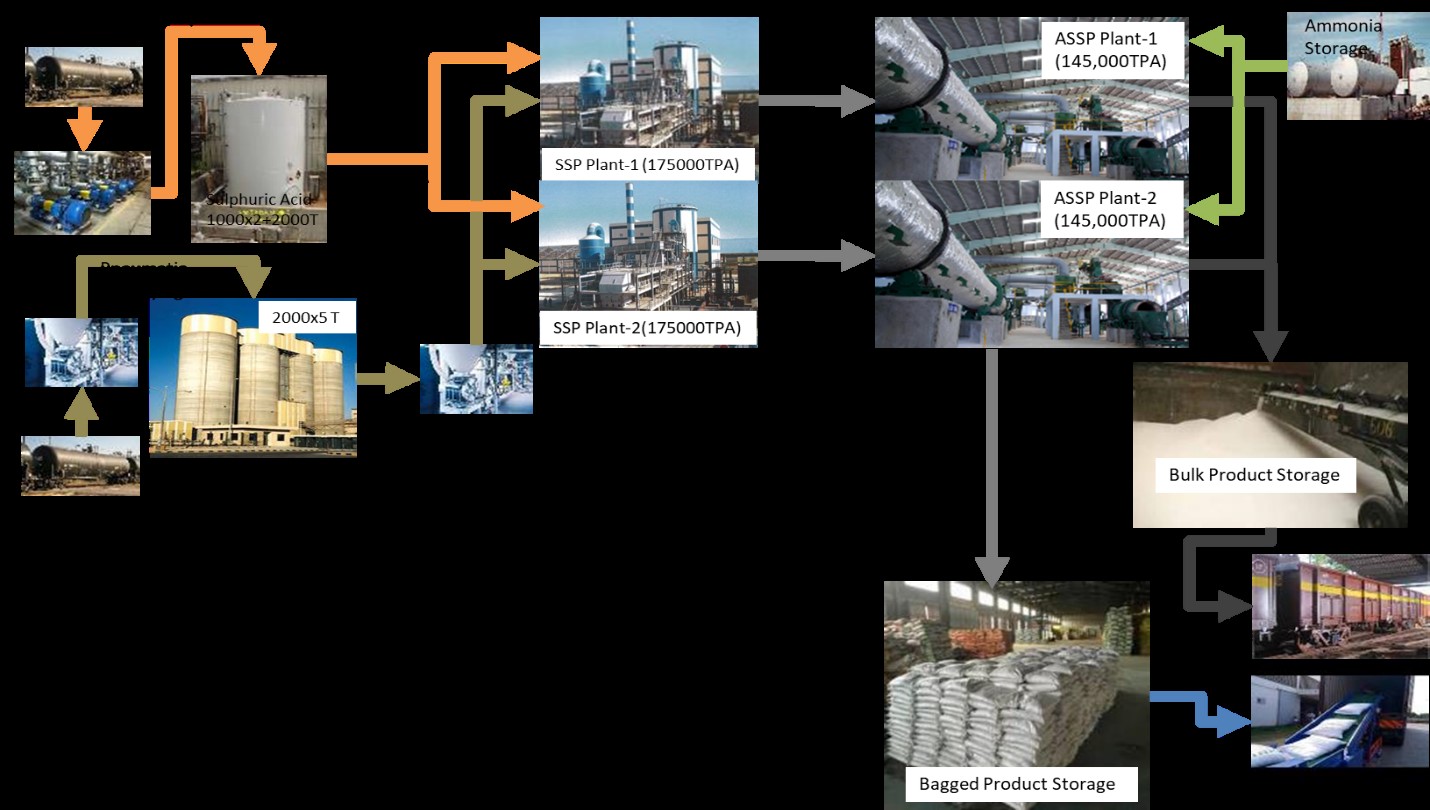Manufacturing Capacity
- Single Super Phosphat Plant, Capacity 350000 tons per year
- Ammoniated SSP, Capacity 290000 tons per year
- Water Soluble Fertilizers, Capacity 2500 tons per year
There are two identical streams to produce SSP. The key raw materials for production of SSP are Concentrated Sulphuric acid and ground rock phosphate. Both the raw materials and water for dilution are allowed to react in a paddle mixer. As the reaction is exothermic in nature the temperature of the reaction mixture increased to about 110°C . In mixer the reaction is completed by 70 % maximum and takes 3 to 4 minutes.
The next reaction is carried out in a slow moving slat conveyor, called DEN. Here the reaction time is allowed 40 to 45 minutes and the reaction is completed about 90 %. The material is lumpy mostly in discharge of DEN, same is cut by a cutter before allowed for storage. Next 10 % of the reaction is completed during storage and the reaction rate here is very slow. It takes about a month for complete reaction. This stage is called CURING. To enhance the rate of curing the storage heaps are reshuffled time to time by using grab crane. The cured product is meeting the desired Quality parameters such as water soluble P2O5 %, Free Acid and moisture content. The best results especially moisture content of SSP benefits in drying of SSP in ASSP plant.
During reaction there is evolution of Gases consist of mostly HF, Water vapour, SiF4 from DEN & Mixer. Same is scrubbed by passing in three stage ventury scrubber. The scrubbed liquor is recycled back to mixer for dilution purpose or used in ASSP plant in Granulator for granulation.
All the process parameters are monitored and controlled by DCS.
There are two identical streams to produce ASSP. Cured Single super phosphate is fed to the granulation Plant through a Lump Breaker and fed to Granulator through Feed Belt Conveyor. In granulator drum, water is sprinkled and ammonia gas is passed to neutralize the free acid present in cured SSP, granules are formed, which are fed to the Dryer Drum, where the Granules of ammoniated SSP are heated by hot air generated through a Natural Gas fired Furnace. The granules in the Dryer Drum after heating reduce the moisture content to 5 %. The hot granules are then sent to double deck vibrating screen for separation of desired size of product. The oversized separated from the top deck of the screen is crushed by a chain mill and recycled back to granulator along with under sizes separated from product in the bottom deck of the screen.
The product size from 2 mm to 4mm is having temperature of 70°C is sent to a rotary drum cooler for cooling down to 40 oC and the product is either sent directly to packing plant for packing into 50 kg PP bags or directly for bulk loading into wagons or stored in the available storage area. ASSP dust evolved in the process of screening, transfers, chain mill, is recovered through bag filter and the escape ammonia from granulator is scrubbed in ventury scrubber. Little amount of H2SO4 is also used in Ammonia scrubber to reduce emission loss The dust generated inside dryer drum is recovered first in cyclones then in wet ventury scrubber. The dust separated in cyclones of drying system is recycled to Granulator. All the process parameters are monitored and controlled by DCS.

1. Rock Phosphate : 12000 MT
2. Sulphuric Acid : 4000 MT
3. Liquid Ammonia : 240 MT
4. SSP : 20,000 MT
5. ASSP : 70,000 MT